#adding numbers in columns; place value
Explore tagged Tumblr posts
Text

Magic Square of Mars 18 Ce British Grimoire magic square and seal For war magic.
Associated Numbers
The numbers associated with Mars are 5, 25, 65, and 325. This is because:
Each row and column of the magic square contains five numbers.
The square contains 25 numbers total, ranging from 1 to 25.
Each row, column and diagonal adds up to 65.
All of the numbers in the square add up to 325.
Divine Names
The divine names associated with Mars all have numerological values of 5 or 65. The names of the intelligence of Mars and the spirit of Mars have a value of 325. These values are calculated by writing out the names in Hebrew and then adding up the value of each included letter, as each Hebrew letter can represent both a sound and a numerical value.
Construction of The Square
The square is constructed by arranging the numbers consecutively in a pre-arranged pattern. In general, numbering moves down and to the right. Hence, 2 is down and to the right of 1. When the down and right motion would take you off the edge of the square, it wraps around. Thus, since 2 is on the bottom edge, 3 is still to the right of 2, but it’s at the top of the square instead of the bottom.
When this pattern runs up against numbers already placed, the pattern shifts two rows down. Thus, 4 is on the left, 5 is one down and one to the right of 4, and if that motion were to be repeated, it would collide with the already placed 1. Instead, 6 appears two rows down from 5, and the pattern continues.
Construction of The Seal
The seal of Mars is constructed by drawing lines that intersect every number within the magic square.
28 notes
·
View notes
Text
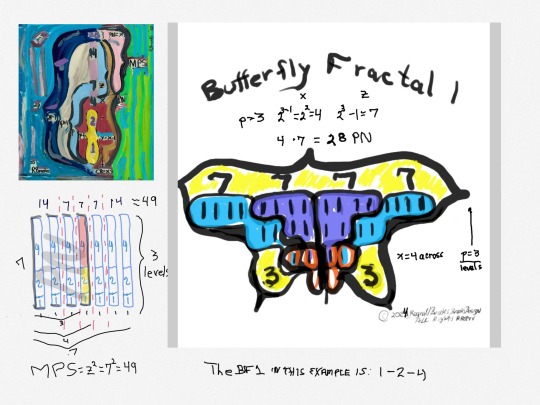
"DMT-EDMT Series for December Geometry #11"
From another perspective...
Yesterday's post (#10)
The Butterfly Fractal 1 (BF1) is a fractal resulting from the simple doubling of quantity "1" -- 1 -- 1x2=2 -- 1x2x2=4. --
When you lay it out into its "Butterfly-like" array, you can see that every "1" becomes a new source for the self-similar, re-iterative redundancy of the same "fractal" pattern within.
The BF1 pattern is repeated on both sides (of the "wings.”)
Today:
Let's connect some dots between several different perspective views of the same information on PN28 with the PN6 embedded within.
Right side: this was Yesterday's post (#10): Shows the BF1 with four levels of "1's" from bottom to top. The PN6 (RED circles) goes up p=2 levels, while the PN28 -- building off the 2nd level, goes up p=3 levels.
TOP Left side: Same info in number symbol form, i.e. the individual "1's" are given their respective numerical symbol: 1=1, 1 1 =2, 1 1 1 1=4. Additionally, the p=3 levels that the PN28 shows reveal a second p=3. -- or 2x3=6 total levels. 28/2=14, 14/2=7 and 7--14--28 are the other 3 (of 6 total) divisors of 28. (NOTE: PN divisors include the PN itself, but by definition, PN are made up of the sum of ALL the divisors except the number itself, e.i. PN28 =1+2+4+7+14, not counting the 28 in the sum total. We call them "factors" (or proper divisors) as divisors-number itself = factors.)
BOTTOM Left side: Contains ALL the same info as in the first two images, but clearly presented in a different form and perspective. It is the basis of the Mersenne Prime Square (MPS)=z² =Mp². The emphasis here is on the simple BF1. This fractal -- 1-2-4 -- that sums to 7, is repeated 7 times to form the MPS. Going from left-->right, two fractal units sum to 14, add one more fractal unit, it sums to 21, that is symmetrical to the other side of the central fractal unit. 21=ODD Complement=OC=yz. Adding the central fractal unit of 7 to the three units of 7 on the left, gives 4 units of 7=28 = PN=xz. Adding together the PN+OC=MPS. Every MPS follows this pattern -- ALL built on the repetitive, re-iterative sequential doubling of quantity one to first form the BF1 and then the same BF1 doubling sequence of that BF1 to give the MPS.
BOTTOM Left -->Right side: The four Columns of BF1 on the Left = BLUE-GREEN and PURPLE "1's" on the Right. You may notice the "x=4 across" label in the Right image. One can always find on any size BF1 the starting Row as it equals the x-value. The x-value on both Left images is always at the p-level, i.e. STEPS along the BF1 sequence -- p=3 as 1=2-4 STEPS, and as 2ᵖ⁻¹ =2² =4=x.
We've covered a lot, but once you see it, all the other PNs, and their "containers" will automatically fall in to place as they all follow the same template.
The Running Sums (∑) are very important throughout. Here we see that the ∑ of fractal unit 1-2-4=7.
more...
#rbrooksdesign#fractals#butterfly fractal 1#perfect numbers#primes#mersenne prime squares#geometry#mathematics#entanglement#quantum entanglement#exponentials#dmt#divisor matrix table#digital art#math#graphics#edmt#number theory#entropy#archives#bim
28 notes
·
View notes
Text
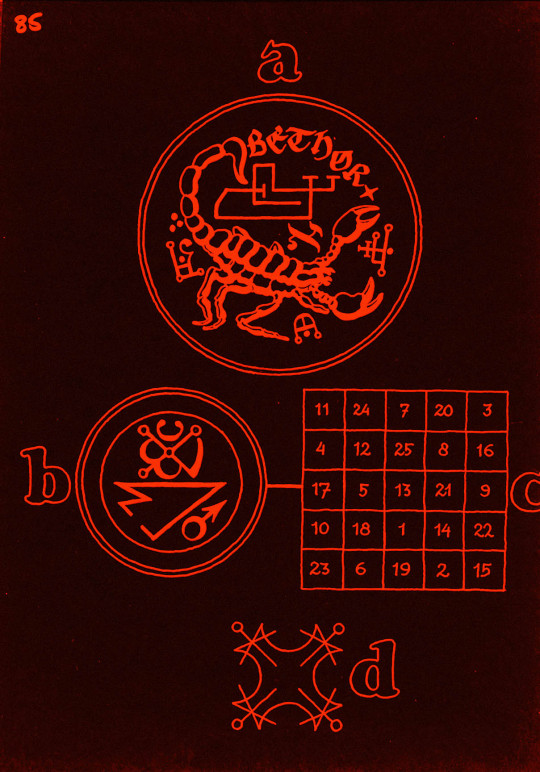
Magic Square of Mars
18 Ce British Grimoire
magic square and seal
For war magic.
Associated Numbers
The numbers associated with Mars are 5, 25, 65, and 325. This is because:
Each row and column of the magic square contains five numbers.
The square contains 25 numbers total, ranging from 1 to 25.
Each row, column and diagonal adds up to 65.
All of the numbers in the square add up to 325.
Divine Names
The divine names associated with Mars all have numerological values of 5 or 65. The names of the intelligence of Mars and the spirit of Mars have a value of 325. These values are calculated by writing out the names in Hebrew and then adding up the value of each included letter, as each Hebrew letter can represent both a sound and a numerical value.
Construction of The Square
The square is constructed by arranging the numbers consecutively in a pre-arranged pattern. In general, numbering moves down and to the right. Hence, 2 is down and to the right of 1. When the down and right motion would take you off the edge of the square, it wraps around. Thus, since 2 is on the bottom edge, 3 is still to the right of 2, but it's at the top of the square instead of the bottom.
When this pattern runs up against numbers already placed, the pattern shifts two rows down. Thus, 4 is on the left, 5 is one down and one to the right of 4, and if that motion were to be repeated, it would collide with the already placed 1. Instead, 6 appears two rows down from 5, and the pattern continues.
Construction of The Seal
The seal of Mars is constructed by drawing lines that intersect every number within the magic square.
47 notes
·
View notes
Text
How to Play Caravan in Fallout New Vegas
I promised a guide on how to play Caravan a bit ago so here it is
Getting a Deck and Finding a Player
Step 1: you'll need Ringo's spare deck, you've probably picked it up at least once while talking to him about Caravan as he'll just hand it to you, as far as i know it's impossible to play without getting this deck in some fashion but I'm fairly sure you can loot it off him if you plan to just kill him on sight for one reason or another
Step 2: you'll need an NPC to play caravan with, there are only a few of them but you'll run across while playing the game if you look through their dialogue, Ringo is the earliest one you'll run across but some other ones of note are Cliff Briscoe, No-Bark Noonan, and Johnson Nash.
NPCs which aren't merchants have somewhat fixed cap counts they're willing to bet on a game, with No-Bark being the highest (he often will put up to 1000 caps down on his first game), playing subsequent games with an NPC will result in them putting less and less down for each time they lose
NPCs which act as merchants will pull a percentage of their store's cap inventory, including the value of any Legion Coin or NCR dollar they have. This makes it possible to buy a ton of stuff from a merchants and then beat them in a game of caravan with a high bet to return most of the caps spent or even more than you spent to begin with, however you can only ever play a total of 5 games with a single merchant per save
Building a Deck
Now that you've found a player you'll be placed into the game's screen when you select the dialogue option to start a game.
You'll be presented with all the cards you have in your inventory, Caravan is not played with a standard deck of cards and can be played with any almost any assortment of loose cards, this screen (shown in the attached image) is where you select what cards you want to have in play when the game starts
the only rule you'll need to worry about when building a deck is you must have at least 30 cards in play, you can have more if you think it's a good idea
the top row is where you'll see the cards you have in play and the bottom row is the cards you have on you but not in play, use the arrow keys to navigate this screen, if you don't want to build a deck for one reason or another hitting S will randomize the cards you have into a playable deck.
more cards can be found to be added to your deck throughout the game, normally as items on merchants that sell for a few caps each, when bought these won't show in your inventory but will be added to your deck.

The Game
Once a deck is confirmed you will move onto the actual game, you'll draw a handful of cards from your deck and your opponent will make their first move

Three columns exist on the board "Boneyard-Dayglow" (Left), "Redding-New Reno" (Middle), and "Shady Sands-The Hub" (Right)
your "caravans" are the stacks of cards that we will build on your side of the board (Dayglow, New Reno, and The Hub), they compete with your opponents caravans placed in the same column (Boneyard, Redding, and New Reno)
a Caravan can be in one of three states: unsold, sold, or overstacked, the state it is in depends on the value of the numbered cards within the stack
A sold caravan is anywhere from 21-26 in value, anything over 26 is overstacked and anything under 21 is unsold. If both of the caravans in a column are within the sold range the Caravan with the higher value sells and the lower value caravan acts as though it were unsold if both are the same value neither will be sold
the game ends when one caravan in all three columns is sold and the winner is determined by which player has sold at least two in their favor.
during the first 6 moves of the game (including your opponents moves) only number cards and aces can be playe, one card must be placed in each column before any other cards can be played

CARDS
The value of a card is simply the number assigned to it, aces act as ones for this purpose so a caravan with a 10 and an ace is worth 11
as you play cards you'll draw more from your deck into your hand, note cards removed from the board do not return to your deck
a deck has an "order" based on ascending or descending value this order is defined when you place the second card on a caravan, example the Dayglow caravan (see the below image) is in a descending order, numbered cards of a value higher than the top numbered card can't be played normally on a descending deck, the inverse is true for a deck which is ascending there are two ways to bypass caravan order
you can either play a matching suit at which point the order rule can be ignored, example a three of clovers is a valid card for the dayglow caravan this would also change the order to ascending for future cards OR a queen can be played which leads us into face cards
Face cards each have a unique function and can be placed not only on your caravans but also on your opponents caravans
Queens will invert the order of a deck but provide no extra value on their own (placing a queen on dayglow in the below image would make it ascending but it's value would remain at 12)
Kings will double the value of the card they're placed on, these can be placed on any numbed card in a caravan not just the top most card (example placing a king on the 10 in dayglow would double it to be worth 20, which would make the overall value caravan value 22)
Jacks will remove the card they're placed on and any face cards which have been attached to it from the board like kings these can be placed anywhere on the deck (placing a jack on the 9 in boneyard would remove the 9 AND King attached to it from the board)
Jokers when placed on numbered cards will remove all cards of that number from the board, not including the card it's been placed on, when placed on an ace it'll remove all of the ace's suit from the board (a Joker on a 9 of spades will remove all 9s from the board, while a joker on an Ace of Spades will remove all Spades from the Board)

19 notes
·
View notes
Text
Here's the full blog post, including an off topic rant about people arguing about types of games online too much:
Story game pick lists and OSR spark tables
I am, against my will, mostly writing things these days that are largely categorized as OSR, so this is kind of aimed mainly at an audience of people in a similar situation.
The difference between a random table and a pick list is that the random table has a second column for numbers, in case you want to choose things randomly. For instance, Blades in the Dark has a list of appropriate names for the setting, and Cairn also has a list of appropriate names for the setting with numbers beside them.
On Discord, the subject of whether pick lists can teach us something about OSR tables came up. One person had a pretty cool idea which I won't share because it's their idea, you'll just have to join the NSR discord to find out. This had me think about a cool thing I'd seen in some pick lists. For instance, Wanderhome has character generation picklists that ask questions like, "choose two you still are and two you arent' any more" or "choose two you are and two you refuse to be." I think this is good inspiration for random tables. Let's imagine this in an OSR table.
Pick one that this dungeon room has and one that it clearly used to have:
A pit trap
A slumbering monster
A chest of gold
A water fountain
A holy altar
A passageway leading down
A valuable relic
Strange writing on the wall
Example 1. Let's say it has a chest of gold but clearly is missing a valuable relic. Well, that poses a mystery. Why is the gold undisturbed? Is it trapped or cursed? Or did the one who stole the relic not value gold the way you might? Or perhaps they're wounded and still around here - they had the strength to carry the relic but had to leave the gold.
Example 2. There is a holy altar but it's missing strange writing on the wall. Maybe the writing was defaced? Maybe this was once an altar to some other god whose very name was erased - perhaps some danger related to that old god still lurks? Or maybe the power of the altar can only be unlocked if the writing can be restored.
This is basically the most cliche spark table I can come up with, but adding the "clearly used to have" makes it a little more interesting.
Also I cheated and added some numbers. I'm indecisive.
This is basically the most cliche spark table I can come up with, but adding the "clearly used to have" makes it a little more interesting.
Also I cheated and added some numbers. I'm indecisive.
Pick one the town provides and one the town would pay good money for
A healer
Plentiful food
Military might
Skilled craftspeople
Political legitimacy
Protection from supernatural dangers
I threw this together in about a minute, but I think it might work as a simple faction system. I'll take it out for a quick spin.
Town A: Has political legitimacy, needs protection from supernatural dangers
Town B: Has military might, lacks food
Town C: Has food, is in desperate need of a healer
There's obvious conflict between B and C here, and a real potential for it to break out into open violence. If C needs a healer, maybe there's some kind of plague spreading? C is especially vulnerable but also the plague could spread to B if they proceed with their plans. Meanwhile, A is above the fray - maybe they're the capital, but why aren't they getting involved? Maybe the ruling family has been taken over by some hidden supernatural forces.
Recently, I was playing around with Mythic Bastionland's faction generation system, and while theirs is a lot better thought out and tested and so on, I think with some work my approach here would not be totally out of place in that kind of game.
I'm not sure that something like this hasn't been done within OSR, but I personally heard about this way of structuring spark tables, sorry, pick lists, from story games. In fact, they now seem so obviously similar that I am now second-guessing myself - do people really consider these two approaches to be so fundamentally different? And yet there are probably a lot of cool ideas we're missing out on, by isolating ourselves in these two camps.
47 notes
·
View notes
Text
An Overview of The Nihilist Cipher
Hello! If you're someone interested in ciphers, read ahead to learn a little about one of my long time favorite ciphers, the Nihilist Cipher.
The Nihilist cipher is a polyalphabetic substitution cipher, which basically means it relies on multiple shift ciphers applied to different letters in the text being encoded. If you're familiar with the Vigenère Cipher, Nihilist is pretty similar in a lot of ways.
I'll go through some history of the cipher, how to encode/decode using it, and how to conduct a known plaintext attack on it. I'll also go over how you might approach attacking it without a known plaintext (mainly because I think it's cool), but it won't be the main focus.
History
The Nihilist Cipher was first used by Russian nihilists against Russia's tsarist regime in the late 19th century. It's since been used as a basis for several ciphers with improved security used in WWII, notably the VIC cipher which is essentially an extremely complex hand-encoded cipher that's part of the Nihilist family.
"If [the VIC] cipher were to be given a technical name, it would be known as a 'straddling bipartite monoalphabetic substitution superenciphered by modified double transposition.'" David Kahn, Number One From Moscow
Usage
Encoding a message requires two things: A key and a Polybius square, known by you and the person you're communicating with. A Polybius square is one of these guys:
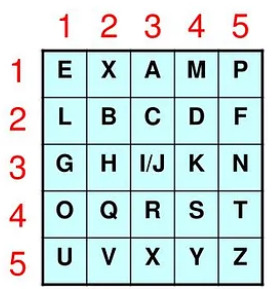
To use the cipher, you must first convert the plaintext into a numeric representation by mapping each letter to a number using the square. The mapping follows a (row, column) scheme, so the letter 'T' in the above square would become '45'. You'll notice that the square is 5x5, meaning there is 1 less square than there are letters in the English alphabet! This is typically solved by either choosing a square to represent 2 letters, differentiated using context by the receiver, or by simply leaving off an unused/infrequently used letter (often Q). It's also common to place a word at the start of the Polybius square, in this case "EXAMPLE" to offset the alphabet and avoid the mappings becoming trivial and obvious to attackers.
After we convert the plaintext to it's numeric representation, that's when the key becomes important. We first encode the key we picked using the Polybius square (i.e. the key MATH would become 14 13 45 32). Then, we repeat the key along the plaintext, and add each plaintext value to the key value to get the ciphertext!
To decode, the receiver must simply repeat the encryption process in reverse: repeating the key across the ciphertext, subtracting the key values, and translating the numeric plaintext back into English text. Because the encryption and decryption processes use the same key, the Nihilist Cipher is considered symmetric.
Known Plaintext Attack
Now we get into the fun part: How can we decode Nihilist encoded text without knowing the key? We will assume we know some ciphertext and the plaintext associated with it. Therefore, our goal is to use what we know to reveal the key, and use the key to decrypt the rest of the cipher. For example, assume we know that the first line of the Bee Movie script, "According to all known laws of aviation", results in the ciphertext "37 66 67 64 35 68 48 53 75 66 57 66 56 84 84 32 57 95 25 84 66 73 36 86 45 65 94 55 37 88 48 85 54".
Since the ciphertext is simply the result of adding the key to the plaintext, to find the key we only need to do the reverse and subtract the plaintext from the ciphertext!

Even with only this short segment, we can see the repeating key is "14 42 43 21 14 43". Now we can repeat this key across the whole message and decrypt the Bee Movie script into numeric encoded plaintext.
At this point, you might be realizing where the next challenge lies. Unless you happen to be in a situation where you don't know the key yet somehow do know the Polybius square, this alone doesn't tell us very much! Since we've essentially converted our original problem into a simple substitution cipher, this is where we employ frequency analysis to figure out which number maps to which letter in the Polybius square. If you're up for a challenge you can do this manually, or use an online tool to analyze the frequency of each number and compare it to how often each letter of the English alphabet appears in typical text. Eventually, you'll be able to decode the Polybius square as the square below.
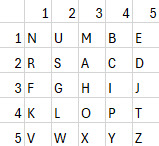
Ironically, the first snippet of The Bee Movie which we knew the plaintext of includes no 'E's, which are the most frequent letter in the English language, but letter frequencies of the full text would end up being much closer to the expected letter proportions.
Congratulations! You've now completed a plaintext attack on the Nihilist cipher and can sit down with a cup of tea for a bit of light reading .
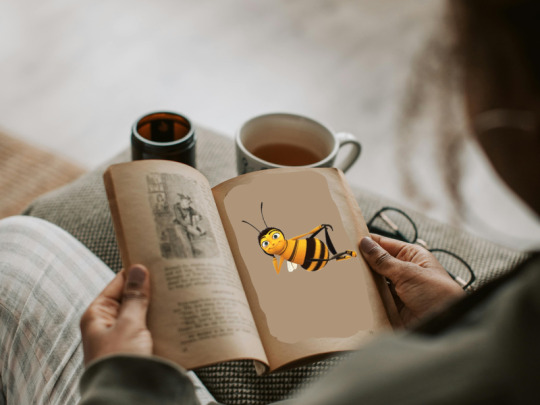
Ciphertext-Only Attack
Now maybe that was too easy for you. Maybe you're a pro cipher-cracker, and you want to decode the Nihilist cipher without some "plaintext crutch". Here's how you can try to approach it! This method will need a large amount of ciphertext available, and relies on statistical analysis, plus some exploitation of the cipher's design to crack it.
The majority of this attack follows the same approach as a statistical attack on the Vigenère cipher. First you determine the key length by testing various key lengths, splitting the text up into groups that would be encoded with the same key, and computing the index of coincidence, which will be high (close to 0.068, the index of coincidence of English text) when the guessed key length is correct.
At this point, if this were the Vigenère cipher, we would have to go on to analyze the mutual index of coincidence between groups of ciphertext characters with the same key shifted by various amounts, but flaws in the Nihilist encoding system mean there's a good chance we can identify the key without this step!
Because of the way the Polybius square is set up, and the lack of modular arithmetic in the encoding method, every key letter value has exactly 25 possible ciphertext numbers that can result from that key. By comparing the ciphertext values encoded with the same shift, we can quickly identify or at least significantly narrow down the shift used to obtain those values! There are even a few cipher text values that immediately reveal what key was used to generate that cipher text (For example, a cipher text value of 30 can only be obtained using key=15). For a full list of possible ciphertext values generated by each key, check out this document I put together.
And that's it!
You are now a certified expert in all things Nihilist cipher. Go forth and use your new skill responsibly, leaving behind cryptic messages everywhere you go.
Happy decoding!

Sources:
https://www.cia.gov/resources/csi/static/Number-One-From-Moscow.pdf https://en.wikipedia.org/wiki/VIC_cipher
https://cyberw1ng.medium.com/nihilist-cipher-an-in-depth-look-at-the-cryptographic-technique-2023-b05b83551957
https://courses.cs.washington.edu/courses/cse163/20wi/files/lectures/L04/bee-movie.txt
16 notes
·
View notes
Text
Caravan Card Game from Fallout: New Vegas - Card Games
What is Caravan
Caravan was designed by Obsidian Entertainment as a fictitious card game played in New Vegas within their video game called Fallout: New Vegas.
Kyle Mifflin’s version simulates as closely as possible the the way that Caravan is played in the video game of Fallout: New Vegas. The only differences are:
That instead of custom decks, each player receives the same deck to make the game as fair as possible (custom decks are allowed as a variant).
That the bug that allows you to discard during the opening round has been removed as an option.
Players and Cards
Caravan is a two-player game using two standard Anglo-American decks of 52 cards plus 2 jokers, one deck of 54 cards for each player.
Player A
Caravan
one
Caravan
two
Caravan
three
Player B
Caravan
one
Caravan
two
Caravan
three
Number cards are placed in an overlapping column within each caravan and each number card may be modified by picture cards placed overlapping to the side.
Throughout the game, Player A's Caravan One will be directly competing against Player B's Caravan One. The same goes for Caravans Two and Three. In addition, each player has a face-down deck from which they draw cards and some cards in their hand, and there is a face-up discard pile.
Objective
Each caravan has a numerical value based on the total value of the number cards in it, possibly modified by Kings. A caravan is 'for sale' when it's value is in the range 21 to 26. A caravan with a value of less than 21 or more than 26 is not for sale. Cards may be added to a caravan that is already for sale to change its value.
The object is to sell at least two of your three caravans. If both competing caravans in a position are for sale, only the higher valued caravan is sold. No sale takes place until there is at least one caravan for sale in each of the three positions at the same time.
Opening Round
To start, each player shuffles their deck, stacks it face down and draws the top eight cards from it to form their initial hand. The opening round in its entirety consists of three turns for each player, playing alternately. Each turn must be used to place one card face up to start off each of their three caravans. During this opening round only number cards (A, 2-10) can be placed. If a player does not have three number cards or aces to play, then they must show their hand, reshuffle their deck and draw eight new cards. No cards can be discarded or re-drawn during the opening round. Therefore at the end of this round when each player has had three turns, they will each have a hand of five cards and one card in each caravan.
Game Play
After the opening round play continues with players taking alternate turns. On each turn, you must do one of the following:
Play a card from your hand on a caravan, then draw a new card from your deck and add it to your hand.
Discard a card from your hand, then draw a new card from the deck to replace it.
Disband one of your caravans. Take all the cards from this caravan and place them on your discard pile.
Note that after the opening round, if any of your caravans is empty of cards you are not required to play on the empty caravan in your next turn: it can be left empty. Technically, you could win the game with only two caravans if you could sell both of them while your opponent sold the third. Any card that is discarded or removed from play is added to the discard pile. These cards can't be recovered.
Playing Number Cards
(A=1, 2-10)
Number cards in each caravan are played in a column. Each new card is added to the bottom of the column overlapping the previous number card. Number cards can only be placed on your own caravans. On an empty caravan, any number card can be played. On a caravan with one card, you may play any number that is not equal to the first card. On a caravan with two cards, the bottom two cards indicate its numerical direction - ascending if the bottom card is higher, descending if it is lower. You may play any card that preserves the direction or any card matches the suit of the bottom card. Example: if the last two cards of a caravan are 3, 7 the direction is ascending. On this caravan you may play any 8, 9 or 10 to continue the ascending direction, or the A, 2, 3, 4, 5 or 6 of hearts changing the direction to descending.
Note that cards following numerical direction do not need to be adjacent in value. For example you can go up from a three to a seven, or down from a seven to a three. Under no circumstances are you allowed to place a number card on an equal number card (e.g. a 10 on a 10).
Playing Picture Cards (J, Q, K, Joker)
Picture cards all have special effects. Unlike number cards which are placed in a column overlapping each other, a picture card is placed to the side of and overlapping the card it is played on. A picture card can be played on a number card in any caravan, no matter whether it belongs to you or your opponent. Jacks, Kings and Jokers can be played on any number card; a Queen can only be played on the bottom card of a caravan's column. The special effects are as follows:
Jack
Removes the card the Jack is played on as well as any face cards attached to it, and place them on the discard pile.
Queen
This may only be played on the last card of a caravan's column. It reverses the current numerical direction of the caravan and changes the suit of the caravan to that of the Queen. Example: if the last two cards of a caravan are 3, 7 and the Q is played on the 7 the numerical direction is changed to descending and the suit to diamonds - so the next card played on this caravan can be any A, 2, 3, 4, 5 or 6 or the 8, 9 or 10 of diamonds. Multiple Queens can be played on the same card.
King
Doubles the value of the card the King is played on. Multiple Kings can be used on the same card (for example a 9 with a King on it is worth 18, a 9 with two Kings on it is worth 36).
Joker
If a Joker is played on an Ace it removes all other number cards (including Aces) from both player's caravans that are the same suit as the Ace on which the Joker was played, along with any picture cards attached to those cards. Picture cards that are the same suit as the Ace are not affected (unless they are attached to a number card removed by the Joker). Number cards and Aces with Queens attached to them count as belonging to their printed suit: the suit of the attached Queens is ignored.
If a Joker is played on a number card from 2-10 it removes all other printed number cards of the same value from both player's caravans, along with any picture cards attached to those cards.
In all cases the card on which the Joker is played and any pictures attached to it are spared. A played Joker only affects cards that have been played before it, not cards played subsequently. All removed cards are added to the discard pile.
Picture cards can be played on number cards which already have one or two other picture cards attached to them. However, no more than three picture cards can be attached to a single number card at one time. Therefore a picture card cannot be played on a number card that already has three picture cards attached to it, and the only way to remove such a card is by the use of a Joker on another card, or by disbanding the caravan. In particular a Jack cannot be used to remove a number card that already has three face cards or Jokers attached to it.
If in the event that a Jack or Joker removes a card leaving a caravan ending with two equal numbered cards, then the numerical direction remains as it was before the card was removed (Example. If a Jack is played on the 7 in this caravan: 6-7Q-6, leaving just 6-6, the direction is descending, since before the Jack was played there was a downward sequence of 7 to 6). This only applies in situations where the removal leaves equal cards following each other. (Example: If a Jack or Joker removes the 6 in this caravan: 2-6-4, then the sequence is now ascending [2-4] and it doesn't matter that beforehand the sequence was descending.)
Winning
To score a caravan you simply add the total sum of a caravan's number cards (as modified by Kings) to determine the caravan's value. When at least one caravan is for sale from each of the three positions the game is over, and the player with two or more of the higher sales wins the game. However, in the event that one of three caravan values is tied between players, the game continues until all three caravans have sold. In this case, if a player has three caravans for sale with two being higher bids and the other being a tie, if it's that player's turn he can simply disband the tied caravan to win the game.
If you run out of cards to play before meeting the criteria of winning, then your opponent automatically wins.
Variants
Optionally, you may play with one Joker each or no Jokers. Optionally, each player may customize their own deck provided that it consists of at least 30 cards (selected from standard 52-card decks with jokers), and doesn't contain any two cards that are precisely the same. The maximum number of cards to be used should be agreed upon before the game. It is recommended that no more than four decks (216 cards) be used to make a player's deck, as there are only four different decks that can be used in the New Vegas version of the game.
Bugs and Discrepancies
Here is Kyle Mifflin's summary of some issues with the original New Vegas game and how these are addressed in his interpretation.
Deck Construction
The actual game of Caravan as found in New Vegas is played with custom decks. You must have a minimum of 30 cards to play with in your deck - the rules do not mention a maximum number of cards allowed in your deck. You may use more than one set of traditional playing cards, and have any number of cards of any type provided they don't include any two cards that are precisely the same (face and back). In practice, deck construction doesn't matter. So long as you're playing with at least 30 cards and don't have two of the same card from identical decks, then you are playing by the rules. A full 54-card deck with Jokers for each player is ideal for even, fair game play. Both players have the same cards and the same advantage. 54 cards is also enough for what could be a battle, should the game go on for that long.
Running Out of Cards
In New Vegas the in-game rules for Caravan do not mention what happens when a player completely runs out of cards to play. However, when this happens in New Vegas the opposing player automatically wins. It's pretty clear that this is supposed to happen since it's been coded into the game.
End of Game Mechanics
This isn't a discrepancy or a bug, but it's something I want to discuss. A lot of people online think that the end-game mechanics of Caravan in New Vegas is bugged. I just want to clarify that having all three of your caravans sold - two at a higher bid and one tied - does not, and is not supposed to end the game. The rules state that the game continues if one of the sold caravan tracks is at a tie. However, I get that it makes sense to end the game when all three tracks are sold and a player has sold two at higher bids. Just note, that while one player just needs to disband their tied track to win the game, if it's the other player's turn then they have a chance to tie another caravan track or to sabotage their opponent's caravan, thus continuing the game indefinitely.
Start of Game Mechanics
The in-game rules in New Vegas state that you are not allowed to discard cards during the opening round of setting up your caravans. However, the in-game coding allows you to do this anyway. It can be accurately surmised that the developers allowed this possibility to avoid dealing with what would happen in you didn't have three number cards to play during the opening round. In any case, this is a confirmed bug. Since the only thing we have to go by when playing in real-life is that you are not allowed to discard during the opening round, if you do not have three number cards to play simply show your opponent your hand, and reshuffle the deck drawing eight new cards. This is my recommended simple solution to a problem which in practice rarely occurs.
References
Kyle Mifflin’s Version of Caravan - Fallout: New Vegas’ Caravan - Invented - Pagat
Fallout: New Vegas Official Website
#warrenwoodhouse#gaming#cardgames#card games#tutorials#tutorial#fallout: new vegas#fallout: nv#fallout new vegas#fallout nv#fallout caravan card game#fallout
5 notes
·
View notes
Text
Periodic table structure

arranging periodic table into blocks, we see that as you go left to right, top to bottom, it follows the increasing energies of subshells w/c occur due to increasing amounts of electron shielding (e.g. 4s → 3d)
n = row number
columns are grouped by l (b/c it indicates s, p, d, or f subshell)
s block elements have outermost electrons in s subshell
p block elements have outermost electrons in p subshell
d block elements have outermost electrons in d subshell
f block elements have outermost electrons in f subshell; f-block elements = lanthanides and actinides and they actually insert themselves here:

rows aka periods = principal quantum number n
Periodic table trends = based on Coulomb's law:

We can't calculate r exactly because of quantum mechanics, so we need to use a mean r value to calculate force of attraction between nucleus and an electron.
Core charge = change experienced by outermost electrons of an atom, assuming the inner electrons shield them 100% from the nucleus and outermost electrons don't shield each other at all.
Ignoring transition metals, core charge = group number (+1 to +8).
In reality, orbitals of outer electrons somewhat penetrate inner orbitals so effective shielding isn't 100% and electrons in the same shell can partially shield each other somewhat. So the actual amount of shielding and effective nuclear charge depends on interactions between different orbitals (e.g. s orbitals have more electron density near or on the nucleus than a p orbital with the same n, so s orbitals shield the nucleus better and is less affected by shielding from other orbitals than p). The actual amount of shielding isn't the same as the amount of shielding assumed in core charge calculations, and thus, the effective nuclear charge does not exactly equal core charge.
Atomic radii
Core charge increases as you go left to right w/c means 1 of the q's in Coulomb's law is increasing, assuming everything else is the same; core charge = one's place of group #. This means force of attraction between outer electron and nucleus increases as you go left to right because the higher the core charge, the more strongly the nucleus pulls the outer electrons towards itself. This means atomic radii decrease from left to right.
As you go down the periodic table, atomic radii increase because you increase in number of energy levels with each period (n ↑).
So largest atomic radii are at the bottom-left of the table.
Ionization energy
Ionization energy = amount of energy (ΔH) that must be absorbed to remove an electron from an atom, to turn the atom into an ion (M → M+ + e-)
We tend to measure energy in enthalpy, so energy = ΔH
The more loosely an atom holds its electrons, i.e. the more electron shielding there is, and therefore the larger the atomic radii, the lower the ionization energy because it's easier for an electron to be removed.
The more tightly an atom holds it's electrons, i.e. the less shielding their is, the smaller the atomic radii, the higher the ionization energy.
So the highest ionization energies are at the top-right of the table (except noble gases because they have full valence shells).
First ionization energy - an outermost electron is removed first
Second ionization energy - a 2nd electron is removed after the first, w/c is always higher than the first because there's greater attraction to nucleus with fewer electrons in the way
You can also have third, 4th, etc. ionization energies, it just depends how many electrons in the atom you have that you want to remove
Sometimes the difference b/t 1st and subsequent ionization energies is small, sometimes it's a really big difference. Difference is really big when you go from outer electrons to core electrons. Difference is small when you're just dealing with outer electrons
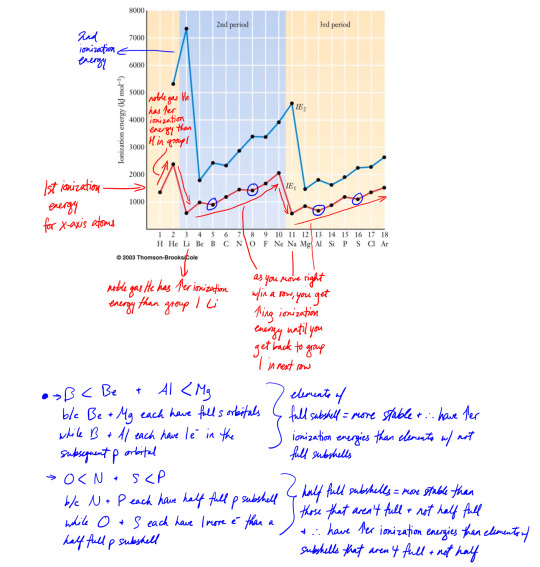
Electron affinity
Electron affinity is the amount of energy (ΔH) released when adding an electron to an atom (M + e- → M-)
All atoms have negative electron affinity except noble gases, so they all can take more electrons except for noble gases, but elements with the highest electron affinity are in the top-right of the periodic table (they tend to form anions)
Metals tend to have low ionization energy and low electron affinity, becoming cations
Non-metals tend to have high ionization energy and high electron affinity, becoming anions
So metals + non-metals → ionic compounds
Metalloids/semimetals can act metallic or non-metallic depending what they're paired with

Electronegativity
Electronegativity is how likely is an atom that shares an electron pair w/ another atom going to attract that pair to itself vs attracted away from it to the other atom and where the electrons spend most of their time? When high electron affinity elements form a covalent bond, they are more likely to hog electrons aka have high electronegativity.
Reactivity

group 1A / alkali metals → lose 1 electron, often form salts (react w/ halogens), reactivity increases as you go down the group
group 2A / alkali earth metals → lose 2 electrons, tends to react with atoms that gain 1 or 2 electrons
group 3A → tend to form 3+ ions except B b/c that would make it very unstable (instead, B forms covalent bonds)
group 4A → C and Si both form tetrahedral structures but Si can have more complex molecule geometries b/c it has d orbitals and tends to lose electrons like metals (hence, it's a metalloid), while C can lose or gain electrons
group 5A → N and P are non-metals forming 3- ions, As and Sb are metalloids so can go either way, Bi is a metal that tends to lose electrons b/c it's a large atom so low ionization energy
group 6A / chalcogens → O, S, and Se are non-metals that can form 2- anions, Te is a metalloid, Po is a metal that tends to lose electrons b/c it's a large atom so low ionization energy
group 7A / halogens → easily form 1- anions b/c they just need 1 more electron to fill their outer shell; F = the most electronegative and has the highest electron affinity of any atom in the table
group 8A / noble gases → least reactive b/c all their outer shells are filled
H can be classified as part of 1A or 7A because it can lose an electron → 1+ or gain an electron → 1-
2 notes
·
View notes
Text
Alignment Charts, Right?
So, Alignment Charts have some sort of strange, supernatural hold over me. I love finding cool ones online, sorting my friends and popular characters into them, and making them too.
I think it has something to do with the way they're a simple way to organize and categorize information/people in fun, uniform ways, and can mean as much or as little sense as you like.
In my "extensive research" of Alignment Charts, I have noticed that there are 3 main types of alignment charts.
The Grid Alignment Charts
The Graph Alignment Charts
The Tree Alignment Charts
The Grid Alignment Charts
This is probably the most common variety of Alignment Chart; a series of tiled geometric compartments. This includes the famous D&D Alignment Chart, as well as the far less popular Bear/Twink/Hunk Triangle.
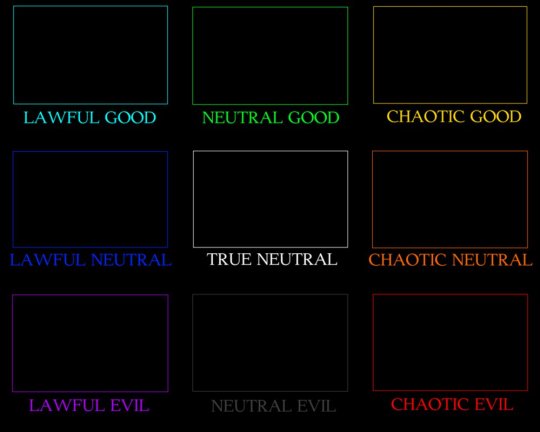

The Square Variety either features two scales of different factors (lawful to chaotic / good to evil) or two collections of different things (preferred drink vs. sexuality is a common one).
The Triangle/Pyramid Variety, however, is a bit more interesting. Instead of having a label at the end of each row, there is only a label at the end of each vertex. As opposed to having the location of a compartment determine its exact value with regard to the chart, the proximity of a compartment to any given vertex determines how much that label applies to what is found in the compartment.
Fun Fact: A square Grid Chart has the same number of compartent as a triangular Grid Chart with the same side lengths! (i.e. A 2x2 square and a 2 layer triangle both have 4 compartments!)
This type of alignment chart is definitely better for smaller, finite sets of data, and allow for more specific and definable areas within the chart.
The Graph Alignment Charts
Graph Alignment Charts, while distinct from their Grid cousins in appearance, are practically identical in function. Again, like their grid cousins, Graph Charts come in both square and triangle varieties. Perhaps the most notable chart of this type is the "McDonalds Triangle Meme," seen here:
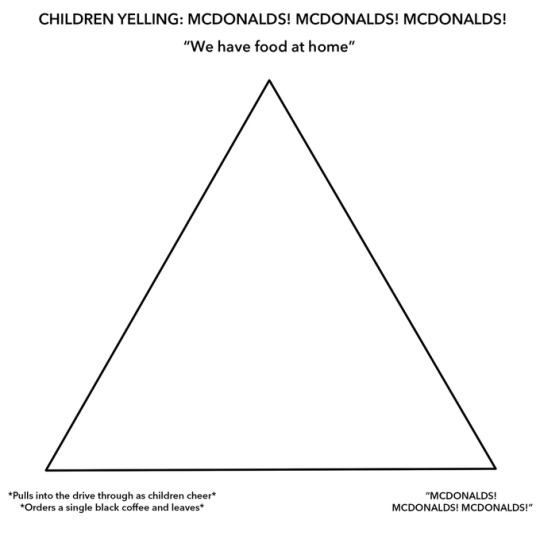
The lack of a grid/compartments allows for a lot more freedom when it comes to placing data points. Their lack of boundaries also allows for many more labels or points to be added in close proximity to one another, meaning that, unlike in Grid Charts, data points don't have to fight for a given spot, they can occupy the same niche in harmony.
The true graph Alignment Charts (As seen below), are an even better example of this category of chart.

While it shares the same labels as the classic 3x3 D&D Alignment Chart, it opts to turn the three columns of order and three rows of morality into axes, meaning one can utilize a greater range of positions, instead of relegating
These types of alignment charts are better suited to larger groups of data and work best when you're trying to relate data points more towards their relationships to a set of labels than more segmented, specific labeling.
The Tree Alignment Charts
This typing is somewhat loose and is more of a catch-all category. I only call them "Tree Alignment Charts" because the Tree Chart is the most structured variant of these charts, and most "Other" charts could be translated into the Tree Chart format and still work as intended. Really, these are the only types:
Tree Charts, which is just what I call the charts.
Freeform "Charts"
I don't think anyone else would call these "Tree Charts," this just looks like the Tree Charts I learned about in math class as a kid. You probably know the Tree Chart by its most famous version: the "When a bag is stuck in the vending machine" chart, seen below.
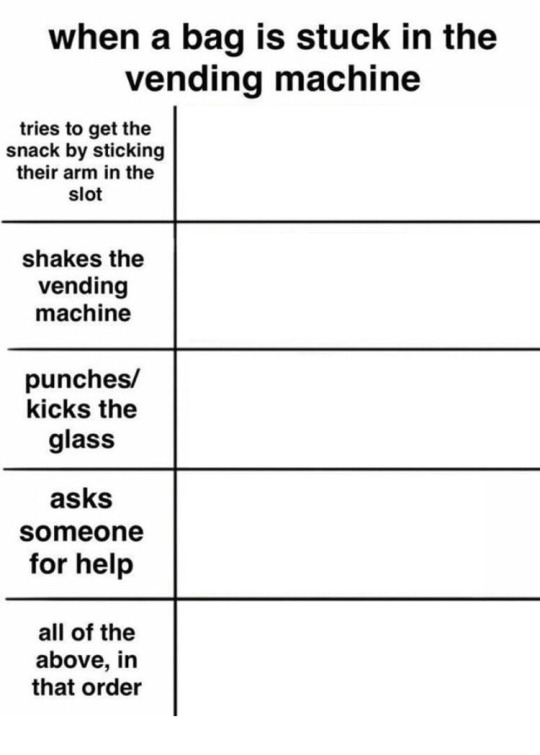
This is a somewhat prevalent version of alignment chart, but definitely not as popular as the classic 3x3 grid chart or the McDonald's-style triangle graph chart.
It's far less based on relation to values or labels, and is really just all or nothing and requires more broad, divided, and unrelated categories.
Finally, the Freeform Charts are just unorganized Tree Charts, as seen below.
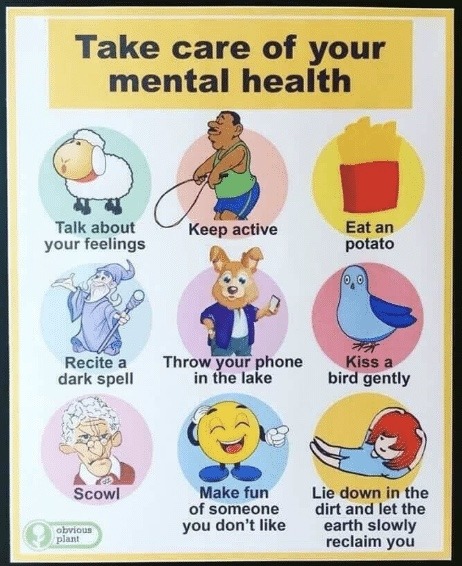
This chart presents a similar format, with different categories of reactions to a singular prompt given in the title, this one just lacks the organization of lines.
There isn't really much to say about these Tree Charts as they are so open-ended.
These Tree Charts are best for displaying random assortments of data with only one set of labels, as opposed to the two sets of labels that both the graph and grid charts utilize.
Conclusion
I didn't really have a goal in mind with this post, I more just wanted to illustrate the different types of alignment charts and what they were good for. Also, I kinda just needed to get some Alignment Chart talk out of my system.
I have a lot of alignment charts saved up that I've found over the years, so I might post some of the more interesting ones at a later date.
Also, I have some varying charts and diagrams that I made as a form of personal indulgence that go into some deep specifics with regard to the values demonstrated within a given chart that I will post on another day.
If you want to hear more about what I think of alignment charts, please let me know or feel free to ask me any questions.
1 note
·
View note
Text
Basic Arithmetic with the Gama Abacus
Basic Arithmetic with the Gama Abacus covers the foundational operations that can be performed using the abacus to enhance calculation skills. These basic arithmetic operations include addition, subtraction, multiplication, and division. Here's how these operations are generally approached using the Gama Abacus:
1. Addition on the Gama Abacus
Concept: Addition on the abacus involves moving beads to represent the sum of two or more numbers. The position of each bead indicates the place value (ones, tens, hundreds, etc.).
Steps for Basic Addition:
Set the first number on the abacus by moving the appropriate number of beads in the correct place value columns.
Add the second number by moving the beads to the appropriate position.
If the sum exceeds the number of beads in a column (for example, moving beads past 10), carry over the excess to the next column (similar to carrying in traditional addition).
Example:
Add 35 + 47. Set 35 on the abacus first, then add 47 by moving beads accordingly. You'll carry over the excess from the ones place to the tens place.
2. Subtraction on the Gama Abacus
Concept: Subtraction involves removing beads from the abacus to reduce a number. Just like with addition, place values are important, and sometimes you need to borrow from higher place values.
Steps for Basic Subtraction:
Set the number to be subtracted from on the abacus.
Subtract the required number of beads by moving beads back (toward the center or starting position).
If you need to subtract a larger number than what is available in the current place value, borrow from the next higher place value (just like traditional subtraction).
Example:
Subtract 48 from 73. Start by setting 73, then subtract 48 by removing beads in the appropriate columns. You'll need to borrow if the beads in the ones column are insufficient.
3. Multiplication on the Gama Abacus
Concept: Multiplication on the abacus is a bit more complex and involves repeated addition or a series of steps. You multiply a number by each digit of the other number, taking place value into account.
Steps for Basic Multiplication:
Set the first number on the abacus.
Multiply by the digits of the second number (this may involve adding the first number multiple times).
Shift beads in the appropriate place value columns and adjust as needed, similar to traditional multiplication steps.
Example:
Multiply 23 by 4. You would add 23 four times on the abacus, and carry over as needed when the total reaches beyond the place value limits.
4. Division on the Gama Abacus
Concept: Division involves distributing a number into equal parts and is essentially the reverse of multiplication. The Gama Abacus helps visually break down the division process.
Steps for Basic Division:
Set the dividend (the number to be divided) on the abacus.
Start dividing by the divisor, moving beads across the place values until you reach the quotient (the answer) and any remainder.
For division problems that don’t result in an even quotient, the remainder is placed in the ones column (or appropriate column).
Example:
Divide 56 by 4. Set 56 on the abacus and divide it by 4, moving beads accordingly. The result is 14, with no remainder.
Key Points for Basic Arithmetic with the Gama Abacus:
Visualization: The Gama Abacus allows students to visualize the arithmetic process by physically moving beads. This helps to reinforce the understanding of place value and operations.
Place Value: Every column on the abacus represents a different place value (ones, tens, hundreds, etc.), making it easier for students to understand how numbers interact during arithmetic operations.
Carrying and Borrowing: As in traditional arithmetic, carrying and borrowing are integral to addition and subtraction on the abacus. These techniques are visually represented by moving beads between columns.
Speed and Accuracy: Regular practice with these operations helps students become faster and more accurate in performing calculations, especially when transitioning to mental math.
By mastering basic arithmetic on the Gama Abacus, students develop a deeper understanding of numbers and mathematical operations, laying a solid foundation for more advanced concepts and mental math skills.
1 note
·
View note
Text
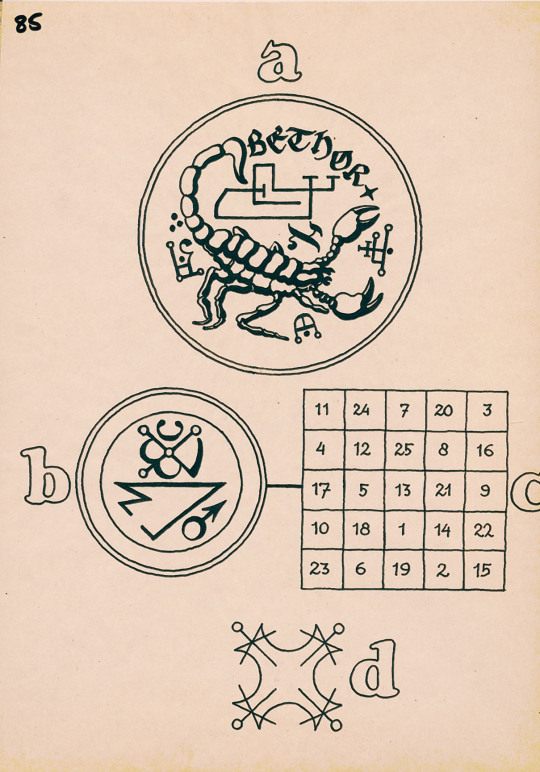
Magic Square of Mars 18 Ce British Grimoire magic square and seal For war magic.
Associated Numbers
The numbers associated with Mars are 5, 25, 65, and 325. This is because:
Each row and column of the magic square contains five numbers.
The square contains 25 numbers total, ranging from 1 to 25.
Each row, column and diagonal adds up to 65.
All of the numbers in the square add up to 325.
Divine Names
The divine names associated with Mars all have numerological values of 5 or 65. The names of the intelligence of Mars and the spirit of Mars have a value of 325. These values are calculated by writing out the names in Hebrew and then adding up the value of each included letter, as each Hebrew letter can represent both a sound and a numerical value.
Construction of The Square
The square is constructed by arranging the numbers consecutively in a pre-arranged pattern. In general, numbering moves down and to the right. Hence, 2 is down and to the right of 1. When the down and right motion would take you off the edge of the square, it wraps around. Thus, since 2 is on the bottom edge, 3 is still to the right of 2, but it's at the top of the square instead of the bottom.
When this pattern runs up against numbers already placed, the pattern shifts two rows down. Thus, 4 is on the left, 5 is one down and one to the right of 4, and if that motion were to be repeated, it would collide with the already placed 1. Instead, 6 appears two rows down from 5, and the pattern continues.
Construction of The Seal
The seal of Mars is constructed by drawing lines that intersect every number within the magic square.
36 notes
·
View notes
Text
How to Use a CRM Software | Top 4 benefits of Using Customer Review Monitoring System( CRM )
In today’s competitive landscape, businesses thrive on strong customer relationships. So as everyone is now a days aware of CRM stands for “customer relationship management”. Where A company’s CRM stores all interactions with potential and existing customers data.
Usage for a custom CRM application development
Step 1: Add your sales people Details
The sooner you can get all the reps on your team using your CRM, the more comprehensive and accurate your data will be monitored. That’s why the very first step in a Custom CRM software implementation should be adding users data. But make sure you’ve explained the value of a CRM Application specifically, how it will be helpful to your sales persons bring in more business and gotten their buy information.
Step 2: Customize your settings
As Your custom crm development should reflect your sales process. That means it accurately maps to the stage customers goes through from lead to opportunity. Of course, that requires knowing those stages in the first place. If you have no idea what your sales process looks like, then take several weeks to observe and measure the way prospects buy your product or service. “Connect, Qualify, Demo, and Close. Create deal stages in your CRM pipeline for each one. Now, you’ve standardized the sales process for your reps.
Step 3: Import your contact, companies, and deals.
If you are currently using a different CRM or spreadsheets to keep track of your prospects and opportunities. Every CRM will let you bring in this information by uploading a CSV file. Each column in your spreadsheet should match a contact property as the custom developed CRM by company, so your data will flow seamlessly between your old and new systems.
Step 4: Integrate your other tools.
Integrate the Marketing, sales, and customer success information should be centralized in your CRM. This gives you a 360-view of your prospects and customers. This will also cuts down on manual data entry. Here’s an example of an inefficient process using several tools: Collect leads using a form builder →Put those leads into your email tool →Export qualified leads to your CRM Imagine this process if you’re using the Kanhasoft CRM with Marketing and Sales. The entire process is seamless and far more efficient.
Step 5: Setting up your dashboard.
You should have a crystal-clear overview of your team’s performance so you can keep the team data aligned and give the right coaching and direction to team. That’s why a Our Custom CRM System has a dashboard is so handy. It’s just like a control panel that you can customize to fit your specific needs. Choose which statistics appear on your dashboard based on your sales objectives and process.
There are four main advantages of using a CRM
Better Customer Experience: It’s much easier to provide a positive buying experience when you know a lot about your prospect. Seeing at a single glance every blog post, email, and ebook they’ve opened to read, as well as key details like their company’s size, location, and vertical, gives you a major details up. You can personalize your messaging and provide more value from the start.
Higher Productivity: Using a CRM, you can automate tasks like call and activity logging, reporting, deal creation, and more. The less time reps are taken on administrative work, the greater number of hours they have to get in front of prospects. Your revenue will increase proportionally for your company.
Increased Collaboration: A sales manager can instantly see how and when her sales people are reaching out to and following up with buyers properly or not. An account executive can quickly fill himself in on an opportunity his sales development rep has prospected and qualified for him. Sales people on the same team can learn more about each other’s best practices and pinch-hit for each other whenever someone goes on vacation or gets sick.
Greater Insights: Stop wondering how your salespeople are doing. A CRM will give you both a high-level and on-the-ground picture and report of rep performance, including team-wide and individual conversion rates by deal stage, average deal size, deal velocity — and that’s just scratching the surface. Imagine what you could do with this data-backed understanding of what’s working and what could be improved.
Kanha Soft CRM system development Company

Our Custom CRM software development services include:
Needs assessment: Define your business if any specific business requirements and objectives.
Design and planning: As per requirement Creating detailed system architecture and design specifications.
Development and implementation: Building and deploying the CRM system by our Developers.
Training and support: Providing comprehensive training and ongoing support to our Customer.

By choosing a reputable custom CRM software development company, you can leverage the power of a tailored solution to. Contact Us a leading custom CRM software company today to discuss your specific needs and explore how a custom CRM solution can transform your business.
For More Details Visit : https://kanhasoft.com/
0 notes
Text

Magic Square of Mars
18 Ce British Grimoire
magic square and seal
For war magic.
Associated Numbers
The numbers associated with Mars are 5, 25, 65, and 325. This is because:
Each row and column of the magic square contains five numbers.
The square contains 25 numbers total, ranging from 1 to 25.
Each row, column and diagonal adds up to 65.
All of the numbers in the square add up to 325.
Divine Names
The divine names associated with Mars all have numerological values of 5 or 65. The names of the intelligence of Mars and the spirit of Mars have a value of 325. These values are calculated by writing out the names in Hebrew and then adding up the value of each included letter, as each Hebrew letter can represent both a sound and a numerical value.
Construction of The Square
The square is constructed by arranging the numbers consecutively in a pre-arranged pattern. In general, numbering moves down and to the right. Hence, 2 is down and to the right of 1. When the down and right motion would take you off the edge of the square, it wraps around. Thus, since 2 is on the bottom edge, 3 is still to the right of 2, but it's at the top of the square instead of the bottom.
When this pattern runs up against numbers already placed, the pattern shifts two rows down. Thus, 4 is on the left, 5 is one down and one to the right of 4, and if that motion were to be repeated, it would collide with the already placed 1. Instead, 6 appears two rows down from 5, and the pattern continues.
Construction of The Seal
The seal of Mars is constructed by drawing lines that intersect every number within the magic square.
17 notes
·
View notes
Text
Writer's Tone Outside of Time
I've been trying for a long time to put my finger on what I like so much about Stewart Brand's writing. I was brainstorming role models for this column Maintenance Man Monthly, which Lia challenged me to write. The list included Tom Cunliffe, the English Sailing guy, Essential Craftsman, and Steward brand was on the list.
He seems very able to describe patterns and trends without adding value judgements to his description. I guess maybe it's from transcending status, but he doesn't … it points out how much the desire to condemn or be snooty, it comes from a place of trying to show that you're better than someone. So maybe he's beyond that. He has this way of talking about what people like and what they don't like without being including himself in those people. Without being one of the people.
It's not like he doesn't have preferences. He has obviously bohemian preferences! But he somehow seems able to stand outside of time in a way that those preferences aren't loaded onto whatever he's talking about. He's willing to talk about TRENDS that last 40 years. He came up with the whole pace layer scheme, but the word "trend" suggests yearly things, fashion trends. But slower things have trends too, and he's talking about architecture, they're still trends, they're still just stuff people like, aesthetically. That's what a trend is. It's an aesthetic preference divorced from … it probably originated in some sort of practical thing at some point, like people painting barns red because iron pigments were cheap, but at this point it's a trend, and people like it because it's visually familiar and traditional, not because they understand the whole iron thing.
So he can think about trends that last decades, trends that last centuries, and that just seems powerful. It's great to notice that you yourself … your own preferences exist within these trends. What if your "identity" or "personality" which you pride yourself on as being "above" trendiness, is actually adherence to a century-scale trend?
The other day I went to an oriental rug store, so the owner's son was showing me around, he explained to me how new rugs, modeled on old designs, are weathered by the makers to imitate patina. And those were the rugs I was drawn to and had asked about. I felt a little embarrassed at how transparent my tastes were. Those Afghani rug makers, they've sure got my number! I instinctively liked it, and I didn't know why.
That's a trend that's probably 80 years old: liking worn oriental rugs. I just appreciate even the idea that trends can last so long and you can begin questioning your preferences based on realizing that.
0 notes
Text
#1154 Where did 0 come from?


Where did 0 come from? The concept of the modern zero was invented in India, but the idea of a placeholder for numbers was thought up by the Mesopotamians. We take the idea of the number 0 for granted. We use it regularly throughout the day (probably) and many of the things we use would not function without it. It is a part of the programming for your phone and for the algorithm that pushes my articles down to the darkest parts of the web. However, that concept has only existed since relatively recently. That is not so strange when you think about it because zero means nothing, and why would you have a number that means nothing? The very concept of numbers is to count things. You would never count nothing because there is nothing there to count. Something similar to zero became necessary when counting systems changed. Early counting systems simply counted the number of things that there were. They used marks or symbols. One mark for one thing, two marks for two things, and so on. However, humans can only rapidly count groups of four things. Any more than that and we can’t do it quickly. That is why a lot of the early counting systems, like Roman numerals, use marks for one, two, three, and then change to other symbols. I, II, III, IV, V, VI etc. There is no need for a zero in a system that just counts what is there. The problem with these systems is that numbers get very long. An easier way is the system that we use today. You have the numbers 1 to 9, and then you have columns for the place values. The first column is for the units. Everything up to nine. The next column is for the tens. Everything up to 90. And the last column is for the hundreds. Everything up to nine hundred. This makes numbers shorter, but you have the problem of what to write when there is no value in that column. Today, we write a zero, but in the early days of counting, the Mesopotamians just left a space. This is not a zero, but it is the first instance of nothing being written. This was approximately 4,000 years ago. The Babylonians came next. They used two small wedges to indicate no values in one of the numerical columns. This is still not a number, though. The Mayans also used a symbol that looked like a zero as a placeholder, but this was also not a separate number. Zero as a placeholder spread through other civilizations as well, but it was never an actual number. The first time zero was used as a number was in 628 AD in India. It probably evolved in India independently and started out as a concept of emptiness, or of nothingness. It was called śūnya, and the idea first appears in India in 458 AD. The rules for the use of zero were set down in 628 AD by an astronomer and mathematician called Brahmagupta, but he talks about zero as though it is already known about, which implies that it appeared before his time. He just clarifies the rules. The concept of zero went from India to Arabia, where it was considered a regular number. In Arabic, zero was called sifir, which was a translation of the Hindi śūnya, which meant empty. From Arabia, it went into Europe via Venice. In Italian, sifir became zefiro, which later became zero. The symbol for zero also evolved over time. Early civilizations used hash marks or other marks to indicate a space. In Mayan, it was portrayed as a tortoise shell shape, which is roundish. In ancient Greece, it was written as a small circle underneath a horizontal line. It started out as the Greek letter omicron (ό), and ended up as a smaller circle and a longer line. In China, it was written as a O, but it might just have been a square with rounded corners. In the early Indian manuscripts, zero was written as a solid black dot. There are some examples of zero being written as a circle in India, but it was more often a dot. When zero travelled to the Middle East and then moved up into Europe it gradually became a larger circle. This was probably because a dot could be mistaken as punctuation or easily missed. Also, as zero became a number in its own right, it was written the same size as all of the other numbers. And this is what I learned today. If you liked that, try these: - #93 Is it possible to get absolute zero? - #569 What is the oldest stone circle in the world? - #610 Why do we say eleven and twelve, and first, second and third? - #650 Why is 0 longitude in London? - #499 How does computer encryption work? Sources https://www.history.com/news/who-invented-the-zero https://www.scientificamerican.com/article/what-is-the-origin-of-zer https://www.ox.ac.uk/news/2017-09-14-earliest-recorded-use-zero-centuries-older-first-thought https://en.wikipedia.org/wiki/Bakhshali_manuscript https://www.cbc.ca/radio/ideas/zero-number-series-ideas-cbc-1.6977700 https://www.livescience.com/27853-who-invented-zero.html https://en.wikipedia.org/wiki/0 Photo by Jakub Zerdzicki: https://www.pexels.com/photo/calculator-20552602/ Read the full article
1 note
·
View note
Text
How to Learn Abacus Maths at Home
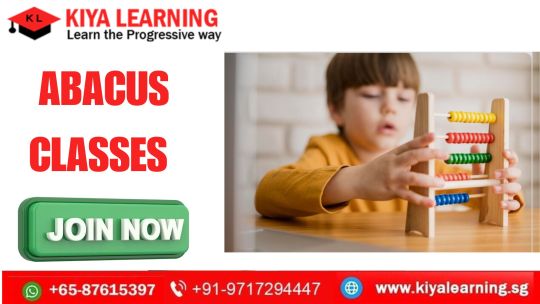
Learning Abacus Maths at home is an exciting way to develop mental arithmetic skills. Abacus Maths is one of the most ancient and effective ways to perform calculations with speed and accuracy. With the right resources, dedication, and a structured approach, you can easily start learning it at home. Let’s explore the steps and tools you can use to begin your Abacus journey.
Step-by-Step Guide to Learning Abacus Maths at Home
Learning Abacus Maths can significantly enhance your mental arithmetic skills, boost concentration, and improve problem-solving abilities. By following a structured approach, you can start learning Abacus Maths at home or through online classes. Here’s a detailed, step-by-step guide to help you get started:
1. Get Familiar with the Abacus
Before jumping into calculations, you need to understand the Abacus tool itself. The Abacus is made up of a rectangular frame with rods, where beads slide up and down. The rods represent place values, and the beads represent numbers.
Identify the structure: Typically, an Abacus has two parts — the upper and lower decks, separated by a horizontal bar. The beads on the upper deck have a value of 5, while those on the lower deck have a value of 1.
Place values: Each vertical rod represents a specific place value (units, tens, hundreds, etc.). The rightmost rod is the units place, and as you move leftward, each rod represents increasing place values.
2. Learn Number Representation on the Abacus
The first step in using an Abacus is learning how to represent numbers. This process helps you understand the tool’s basic working mechanism.
One-digit numbers: On each rod, push one bead from the lower deck upward to represent numbers 1 to 4. For 5, push one bead from the upper deck down to the horizontal bar.
Multi-digit numbers: As you move to higher numbers, use additional rods for tens, hundreds, etc. For example, to represent 23, move 2 beads up in the tens column and 3 beads up in the units column.
Practice number formation: Start by practicing forming numbers from 1 to 100 on the Abacus. This will help you get comfortable with the placement of beads and place values.
3. Master Basic Arithmetic Operations
Once you understand how to form numbers on the Abacus, it’s time to move on to basic arithmetic operations: addition, subtraction, multiplication, and division. Start with simple operations and gradually increase the complexity.
Addition: Practice adding small numbers by moving beads upward. For example, to add 3 + 2, first move 3 beads in the units rod upward, then add 2 more beads. Once the total exceeds 5, move one bead from the upper deck to represent the sum.
Subtraction: Practice subtraction by moving beads downward. For example, to subtract 2 from 5, push 2 beads back down. You’ll also need to learn how to "borrow" when working with multi-digit numbers.
Multiplication and division: These are more advanced operations that require practice and understanding of patterns on the Abacus. Once you’re comfortable with addition and subtraction, start practicing multiplication and division.
4. Learn the Abacus Bead Movements
The most critical aspect of mastering the Abacus is learning how to manipulate the beads quickly and accurately. Here are some tips:
Use your thumb and index finger: When sliding beads, use your thumb to move the lower deck beads up and your index finger to move them down. For the upper deck, use your index finger to move the beads.
Start slow, then build speed: At first, focus on accuracy rather than speed. As you become more comfortable, you can gradually increase the speed at which you move the beads and perform calculations.
5. Develop Mental Visualization Techniques
The real power of the Abacus comes from being able to visualize the tool in your mind and perform calculations without physically using the Abacus. This is called "mental math" or "mental abacus."
Practice visualization: Start by visualizing the Abacus in your mind and mentally performing simple operations like addition and subtraction. Imagine the beads moving as you perform the calculation.
Gradually increase difficulty: As you become more comfortable with mental visualization, try performing more complex operations, like multiplication and division, without the physical Abacus.
6. Join Online Abacus Classes
For a more structured learning experience, enrolling in abacus online classes is highly recommended. Platforms like Kiya Learning offer comprehensive Abacus classes that guide learners through every stage of the process.
Expert instruction: Kiya Learning provides access to experienced instructors who can explain concepts clearly and offer personalized feedback.
Interactive tools: Many online classes offer virtual Abacus tools that simulate a real Abacus, making it easy to practice even if you don’t have a physical Abacus.
Flexibility: Online classes offer the flexibility to learn at your own pace and from the comfort of your home.
7. Practice Consistently
As with any skill, regular practice is key to mastering Abacus Maths. Set aside a specific time each day for practice.
Start with simple problems: Begin with basic addition and subtraction problems. Focus on accuracy before moving on to more complex calculations.
Increase complexity gradually: Once you’re comfortable with basic operations, start working on more challenging problems, including multi-digit multiplication and division.
Use practice worksheets: Many online platforms offer downloadable worksheets to practice different arithmetic operations. You can also create your own problems for additional practice.
8. Track Your Progress
Keep track of your progress by timing how long it takes you to complete different sets of problems. As you practice more, you’ll notice that both your speed and accuracy improve. Challenge yourself by setting time limits for completing problems.
Work on weak areas: If you notice that certain operations (like multiplication or division) are taking longer or causing mistakes, spend extra time practicing those areas.
Celebrate small wins: Recognize your improvements along the way, whether it’s completing a set of problems faster than before or being able to visualize the Abacus more clearly in your mind.
9. Challenge Yourself with Advanced Techniques
Once you have mastered the basics of Abacus Maths, you can move on to more advanced techniques, such as:
Complex multiplication and division: Practice long multiplication and division problems using the Abacus.
Mental Abacus: Try to perform more calculations mentally, without using the physical Abacus. Start with small numbers, then gradually move to larger, more complex problems.
Compete in Abacus competitions: Some platforms, like Kiya Learning, offer the opportunity to participate in Abacus competitions where you can challenge yourself and see how you compare to other learners.
10. Combine Abacus with Vedic Maths
To further enhance your mathematical abilities, you can combine Abacus Maths with Vedic Maths. Vedic Maths is a system of mental math that uses shortcuts and tricks to solve complex problems quickly. By combining both systems, you can develop exceptional calculation speed and accuracy.
Enroll in Abacus and Vedic Maths Online Classes: Platforms like Kiya Learning offer courses that cover both Abacus and Vedic Maths. These classes will teach you how to use both systems together for even faster and more efficient problem-solving.
Final Thoughts
Learning Abacus Maths is a step-by-step process that requires patience, practice, and dedication. By following this guide, you can build a strong foundation in Abacus, improve your mental math skills, and perform calculations with ease.
Whether you’re a beginner or looking to refine your skills, joining an abacus online class like the ones offered by Kiya Learning can accelerate your progress and provide expert guidance along the way. With regular practice and a focus on mental visualization, you’ll soon be able to perform complex calculations without even needing the physical Abacus.
2. Start with Basic Concepts
To get a strong foundation, begin by learning:
Place Value: Each bead in a specific column has a distinct value, such as units, tens, or hundreds.
Bead Movements: Learning how to manipulate the beads is crucial. Practice sliding beads up and down using your fingers, as this will be the core of your calculations.
Number Representation: Start by representing numbers on the Abacus and understanding how different numbers are displayed.
3. Learn Basic Arithmetic Operations
Once you are familiar with the layout of the Abacus and how numbers are represented, start practicing the basic arithmetic operations:
Addition: Learn how to add small numbers first and then gradually increase the difficulty.
Subtraction: Practice subtracting numbers by moving beads appropriately.
Multiplication & Division: Once comfortable with addition and subtraction, you can move on to multiplication and division.
At this stage, enrolling in an Abacus online class can provide structured guidance. Kiya Learning, a popular platform, offers comprehensive courses that can help learners at any stage. Their Abacus classes cover everything from the basics to advanced techniques, making it easier to understand and apply Abacus Maths.
4. Use Digital Tools and Resources
There are numerous online tools, tutorials, and apps available that can assist in learning Abacus Maths. Some of these tools provide interactive exercises, videos, and quizzes that help reinforce your learning. These resources can simulate a physical Abacus, making it easier to practice even when you don’t have a physical tool.
You can also explore abacus learning online platforms like Kiya Learning, which provide step-by-step guidance and personalized support. These platforms are ideal for beginners looking for structured lessons.
5. Practice Daily
The key to mastering Abacus Maths is consistency. Set aside time each day to practice, even if it's just for 15 to 30 minutes. Focus on speed and accuracy while performing simple calculations, and gradually increase the difficulty as you progress. You can challenge yourself by setting time limits to complete problems or by moving on to more complex operations.
Daily practice will also improve your mental math skills. Over time, you’ll begin to perform calculations without even needing the Abacus, as it trains your brain to visualize the movement of beads and perform operations mentally.
6. Join Abacus and Vedic Maths Online Classes
While self-study is important, sometimes expert guidance is needed to truly excel. Joining an abacus and vedic maths online class offers structured learning, expert instruction, and interactive sessions that enhance your understanding.
Kiya Learning offers some of the best abacus classes online for both kids and adults. Their instructors are experienced, and their course material is designed to accommodate learners at every level. In addition, Kiya Learning provides comprehensive lessons on both Abacus and Vedic Maths, which complement each other in building strong mental arithmetic skills.
7. Challenge Yourself with Mental Math Classes
Once you’ve built a strong foundation in Abacus, it’s time to level up with mental math classes. The key to mastering Abacus is to internalize the concepts to the point where you no longer need the physical tool to perform calculations. You can do this through mental math practice, which involves visualizing the Abacus in your mind and manipulating the beads mentally.
By enrolling in mental math classes near me, you can improve your ability to perform calculations without using the Abacus, thereby enhancing your mathematical ability. Kiya Learning also offers mental math classes that are designed to sharpen your calculation speed and accuracy.
Why Choose Abacus Learning Online?
The advantages of learning Abacus online are numerous. Some of the key benefits include:
1. Flexibility
One of the biggest benefits of learning Abacus online is flexibility. You can learn at your own pace, on your own schedule, from the comfort of your home. This makes it ideal for busy adults or kids who are balancing school, extracurricular activities, and other commitments.
2. Access to the Best Instructors
Online platforms often provide access to top instructors from around the world. Platforms like Kiya Learning offer access to highly qualified teachers who specialize in Abacus and Vedic Maths. You can benefit from their experience and expertise without needing to travel or attend in-person classes.
3. Interactive Learning Experience
Many online Abacus classes use a variety of tools to make learning more interactive and engaging. This can include virtual Abacuses, video tutorials, and real-time feedback. Some platforms even offer live classes, where you can interact with instructors and other students, ask questions, and get immediate assistance.
4. Affordable Learning
Compared to traditional in-person classes, abacus online classes are often more affordable. Many platforms offer subscription-based services or one-time payment options for lifetime access to course material. This makes it easier to get started without a large financial commitment.
Kiya Learning: Your Ideal Partner for Abacus Learning
When it comes to learning Abacus online, Kiya Learning is one of the leading platforms. They offer a range of courses that cater to different learning styles and levels, from beginners to advanced learners. Whether you’re looking to improve your math skills for personal development or as a stepping stone to more complex subjects, Kiya Learning has you covered.
Why Choose Kiya Learning?
Comprehensive Curriculum: Kiya Learning offers a structured curriculum that takes you from basic concepts to advanced techniques, ensuring a smooth learning experience.
Expert Instructors: Their instructors are highly experienced and specialize in teaching both Abacus and Vedic Maths. They provide personalized guidance to help you master the skills you need.
Interactive Tools: Kiya Learning’s platform is designed to be engaging and interactive, making it easier to understand and retain concepts.
Flexible Learning: You can learn at your own pace, making it convenient for busy schedules. They also offer flexible payment options, making their courses accessible to everyone.
Whether you're an adult looking to improve your mental math skills or a parent seeking a reliable platform for your child’s math education, Kiya Learning has the resources to help you succeed.
Conclusion
Learning Abacus Maths at home is a rewarding journey that enhances your calculation speed and mental agility. By starting with basic concepts, practicing regularly, and taking advantage of online resources, you can quickly develop proficiency. Abacus online classes offered by platforms like Kiya Learning provide the structure and expert guidance you need to succeed.
Their courses are designed to cater to all ages and skill levels, making them one of the best options for anyone looking to improve their math skills. Additionally, combining Abacus and Vedic Maths can take your mental arithmetic to new heights, providing a strong foundation for lifelong learning.
If you're serious about mastering Abacus, now is the time to take the plunge and enroll in one of the best abacus classes online through Kiya Learning. With dedication and the right resources, you can master Abacus Maths from the comfort of your home!
#AbacusClassesSingapore#AbacusLearning#AbacusMaths#MentalMaths#KidsMathsClasses#SingaporeEducation#MathsForKids#EarlyLearning#MathsSkills#AbacusOnlineClasses#SingaporeTutoring#MathEnrichment#MathClassesSingapore#MentalAbacus
0 notes